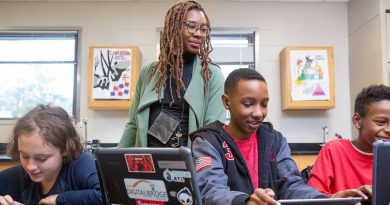AI Can Solve an Algebra Equation in Seconds. Here’s How Math Teachers Can Adapt
ChatGPT, Photomath, Symbolab, and other artificial intelligence-powered platforms can solve a complicated math equation in just seconds—and provide a step-by-step explanation of the answer.
That power of AI is pouring accelerant on a conversation already underway in schools around the country: How can math move beyond worksheets filled with context-free equations and put more emphasis on using numbers to solve real-world problems?
When students can simply take a picture of their math homework and upload it to an app to get the answers, then there needs to be a radical shift in how math is taught and assessed, some educators and experts say.
If schools are merely teaching math as a series of different operations without any real context, “it’s really just mimicking the procedures [that] these technology tools are doing way more efficiently than we can as humans,” said David Dai, who teaches middle school math at the Barton Academy for Advanced World Studies, a public magnet school in Mobile, Ala.
“However, if the focus is on learning to make sense of problems and persevere in solving them or being able to create mathematical models, that requires a level of thinking that these tools” cannot match, said Dai, who is also on the board of the National Council for Teachers of Mathematics.
For instance, for a probability unit, instead of just giving students a bunch of numbers to consider, Dai had his students create survey questions for their classmates featuring questions such as: What’s the best video-streaming service? What’s your favorite shoe brand?
The students collected the data and used it to calculate the probability that any particular 8th grader preferred, for instance, DisneyPlus to Netflix or Adidas to Nike. The exercise taught both statistical analysis and data collection, in addition to probability in a way that was meaningful to students, Dai said.
A difficult shift away from more traditional instruction
Teaching in this richer, more problem-solving way requires a lot from teachers and is a big move away from how most educators learned math themselves, educators acknowledge. It’s also not how most state standardized tests measure subject knowledge.
Plus, some math educators and experts will argue that students need to learn the foundational skills in math before they can begin to use those skills to solve real-world problems. For instance, a student needs to know how to solve a basic algebraic equation before they can use algebra to figure out how to address income inequality.
In your view, how—if at all—should math instruction change to address the existence of artificial intelligence (AI) platforms that can solve math problems for students? Select all that apply.

But advocates of a problem-solving approach counter that it helps students understand the reason behind math concepts and how they might be applied in real life, said Kevin Dykema, who teaches middle school math in Michigan and is the president of NCTM.
If students aren’t given that context, they “don’t see a need for” math, Dykema said, especially now that AI tools can do their homework for them.
“Why would I want to memorize the volume of a sphere formula?” Dykema said. “I can just ask Siri. ‘Hey, Siri, what’s the volume of [this] sphere?’ And Siri will spit out the answer. … It’s not to say that some of those basic fundamental skills are unimportant. They are absolutely important. But I think we’ve had an over-obsession with focusing on some of those things. And the world of technology, especially with AI, is forcing math education to rethink what it is that we’re teaching and how it is that we’re teaching to better meet the needs of our students and to increase opportunities for our students.”
‘Let kids know you’re not afraid of it’
Momentum for this broader, more problem-solving approach to math has been building for years. It is a cornerstone of California’s new math standards, for instance.
But for the most part, educators aren’t seeing math education transforming in this new era of readily available AI tools. Instead many math educators favor dealing with Photomath, ChatGPT, and similar tools by blocking or negating their use, according to a survey of 1,156 teachers, principals, and district leaders conducted by the EdWeek Research Center from May 31 through June 9.
Nearly half of educators who responded—43 percent—said that students should be required to use paper and pencil in class so that it’s clear they are doing their own work in math. Another 37 percent suggested directing students to explain out loud the steps they take in solving a particular problem so they can demonstrate their own understanding. Twenty-eight percent suggested telling students that using AI to solve problems is akin to plagiarism. And 14 percent supported banning the tools altogether.
Over a third of educators—34 percent—suggested that students be taught how to use AI to tackle math assignments. Eighteen percent believe that math instruction needs to change to emphasize the kind of critical thinking and real-world problem-solving that an AI-powered tool is not currently capable of doing.
Dykema understands the impulse to teach foundational skills as if those AI tools didn’t exist, but he doesn’t agree with that approach.
“I also recognize our students do not live in the school building at all times,” Dykema said. “They’re all savvy enough that as soon as they walk out the door, they’re going to utilize all those things. I would much rather have those conversations about how to use them appropriately.”
One possibility: Turn the AI tool’s work into a type of research project, suggested Valerie Bennet, the program director for graduate teacher education at Clark Atlanta University. Give students a set of five problems and have them use a pen and paper to solve them. Then try outsourcing them to the AI tools. Did the platforms come up with different answers? Different methods? Which is most efficient? What did the AI-powered tools miss that humans may have mastered?
Those types of discussions get students thinking more deeply about math and also serve to “let the students know that you’re aware and you’re not afraid of it,” Bennet said. “Kids will know that they’re not pulling wool over your eyes” by using those tools “because you know about them.”
Source: https://www.edweek.org/technology/ai-can-solve-an-algebra-equation-in-seconds-heres-how-math-teachers-can-adapt/2023/09




